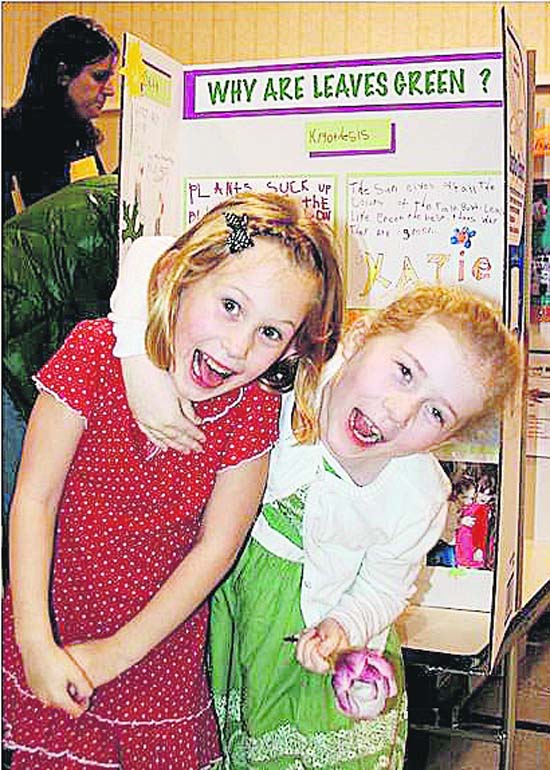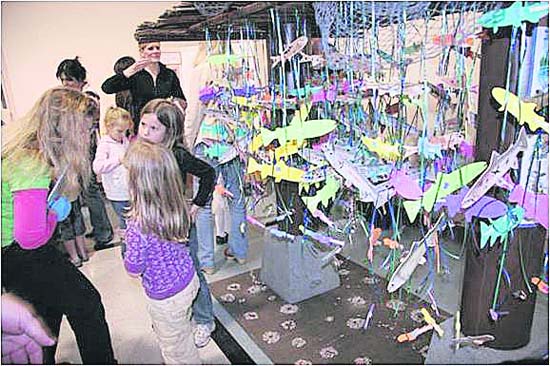| | Published April 1st, 2009
| PLANTS, TROUT, TREBUCHETS AND OTHER SCIENTIFIC PONDERANCES
| | Submitted by Caroline Tsuyuki |  | | Cora Murray (L) and Katie Strohmeyer (R) share a laugh in front of their poster at the LASF Science Fair
Photo courtesy of Kevin Strohmeyer
|
What makes leaves green? If you ask Cora Murray, a kindergartner at Lafayette Elementary School, she will tell you that "leaves get blue from the sky and yellow from the sun." Indeed, it makes sense from a kindergartner's perspective.
 Not to be outdone, Cora's friend and classmate, Katie Strohmeyer, offers her own opinion. Katie believes that "the sun gives out all the colors of the rainbow. Plants like the color green the best!"
Not to be outdone, Cora's friend and classmate, Katie Strohmeyer, offers her own opinion. Katie believes that "the sun gives out all the colors of the rainbow. Plants like the color green the best!"
 Cora's and Katie's experiment and the work of 391 other children at Lafayette Elementary School were the main attraction in the largest ever Lafayette Arts & Science Foundation (LASF) Science Fair in the school's history. This number of participants represents 86 percent of the school's student population.
Cora's and Katie's experiment and the work of 391 other children at Lafayette Elementary School were the main attraction in the largest ever Lafayette Arts & Science Foundation (LASF) Science Fair in the school's history. This number of participants represents 86 percent of the school's student population.
 The fair spotlighted many firsts: a potato cannon (dubbed "The Spud King"), a homemade hamster labyrinth, a handcrafted catapult...excuse me, trebuchet. First graders created a magnum opus production showing the Life Cycle of Trout, the culmination of an ongoing collaboration of the Science program at Lafayette Elementary with the Diablo Valley Fly Fisherman's Association and the California Department of Fish and Wildlife. Classic science experiments shared bench space with numerous "kid-ventions" and teachers initiated class projects that captured children who typically did not participate in Science Fairs.
The fair spotlighted many firsts: a potato cannon (dubbed "The Spud King"), a homemade hamster labyrinth, a handcrafted catapult...excuse me, trebuchet. First graders created a magnum opus production showing the Life Cycle of Trout, the culmination of an ongoing collaboration of the Science program at Lafayette Elementary with the Diablo Valley Fly Fisherman's Association and the California Department of Fish and Wildlife. Classic science experiments shared bench space with numerous "kid-ventions" and teachers initiated class projects that captured children who typically did not participate in Science Fairs.
 The success of this year's fair is a far cry from the 90 participants just two years ago. Energizing the student population required many changes to the fundamental requirements of presenting. The biggest change came with the elimination of the requirement for using only the Scientific Method. Children are now allowed to present research posters and projects on any scientific topic they are interested in.
The success of this year's fair is a far cry from the 90 participants just two years ago. Energizing the student population required many changes to the fundamental requirements of presenting. The biggest change came with the elimination of the requirement for using only the Scientific Method. Children are now allowed to present research posters and projects on any scientific topic they are interested in.
 "While the structure of the Scientific Method helps some students with the organization of their thoughts, it is important for children to remain open to different approaches which come naturally to them" says Jonathan Winter, Lafayette Elementary's science specialist. "Children are 'organic learners' who follow their natural curiosity and make connections that adults no longer question."
"While the structure of the Scientific Method helps some students with the organization of their thoughts, it is important for children to remain open to different approaches which come naturally to them" says Jonathan Winter, Lafayette Elementary's science specialist. "Children are 'organic learners' who follow their natural curiosity and make connections that adults no longer question."
 One of the best examples of questions Mr. Winter has heard was asked by a kindergarten student. Do worms get splinters? "Answering that question opened up a whole host of other questions about worms, adaptations, habitat and body structure, a proverbial 'can of worms.'"
One of the best examples of questions Mr. Winter has heard was asked by a kindergarten student. Do worms get splinters? "Answering that question opened up a whole host of other questions about worms, adaptations, habitat and body structure, a proverbial 'can of worms.'"
 Mr. Winter believes that the most important thing we can do to teach children science is to foster a love for and curiosity of how the world around us works. "The foundation we build must be based on sound science ideas, but enthusiasm for learning is crucial and exposure to hands-on science is essential."
Mr. Winter believes that the most important thing we can do to teach children science is to foster a love for and curiosity of how the world around us works. "The foundation we build must be based on sound science ideas, but enthusiasm for learning is crucial and exposure to hands-on science is essential."
 This philosophy is shared by LASF which underwrites Science Fairs district-wide. LASF together with science specialists and classroom teachers provide Lafayette students with a three-pronged, highly-enriched science experience.
This philosophy is shared by LASF which underwrites Science Fairs district-wide. LASF together with science specialists and classroom teachers provide Lafayette students with a three-pronged, highly-enriched science experience.
 "Without the demonstrations and experiments, science is a dead subject and there's not much excitement in it," says Mr. Winter.
"Without the demonstrations and experiments, science is a dead subject and there's not much excitement in it," says Mr. Winter.
 If the numbers at this year's LASF Science Fair are any indication, science is alive and well at Lafayette Elementary School.
If the numbers at this year's LASF Science Fair are any indication, science is alive and well at Lafayette Elementary School.

|
 | | Grace Dixon (L), LASF volunteer and Lafayette Elementary mom, speaks with children about the Life Cycle of Trout project she helped coordinate with first grade teachers. The large walk-around, walk-through project complete with river sound effects, drew large crowds at the school's Science Fair.
|
| | | |
